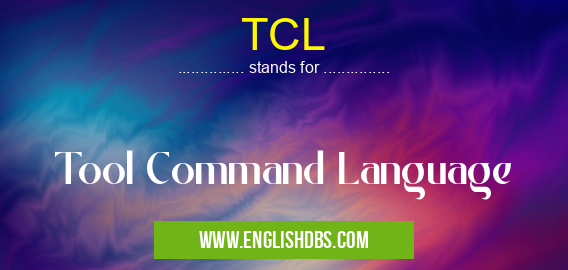What does TCL mean in LANGUAGE & LITERATURE
TCL (Tool Command Language) is a powerful, open-source scripting language designed for controlling and extending applications. It provides a flexible and efficient way to automate tasks, create custom commands, and develop complex scripts. TCL is widely used in various domains, including system administration, network management, database programming, and graphical user interface (GUI) development.

TCL meaning in Language & Literature in Academic & Science
TCL mostly used in an acronym Language & Literature in Category Academic & Science that means Tool Command Language
Shorthand: TCL,
Full Form: Tool Command Language
For more information of "Tool Command Language", see the section below.
Features of TCL
- Cross-platform compatibility: TCL runs on multiple operating systems, including Windows, macOS, Linux, and Unix-like systems.
- Extensibility: TCL allows users to extend its functionality by creating custom commands and libraries.
- Interpreted language: TCL is an interpreted language, which means that it executes commands line by line, making it easier to debug and modify scripts.
- Object-oriented programming: TCL supports object-oriented programming, enabling the creation of reusable and modular code.
- Event-driven programming: TCL can handle events from the underlying system or user input, allowing for responsive and interactive applications.
Applications of TCL
- System administration: TCL is extensively used for system administration tasks such as managing files, processes, and services.
- Network management: TCL is utilized in network management for configuring and monitoring network devices, analyzing traffic patterns, and automating network troubleshooting.
- Database programming: TCL is commonly used for interacting with databases, performing queries, and manipulating data.
- GUI development: TCL is a popular choice for developing graphical user interfaces due to its flexibility and the availability of GUI toolkits like Tk.
- Automation and scripting: TCL excels in automating repetitive tasks, creating custom commands, and extending the functionality of existing applications.
Essential Questions and Answers on Tool Command Language in "SCIENCE»LITERATURE"
What is TCL?
TCL (Tool Command Language) is a high-level, interpreted, dynamically typed, cross-platform programming language designed for scripting network applications. TCL provides commands for manipulating data structures, performing I/O, and controlling the flow of execution. It is often used for scripting tasks, automation, and creating user interfaces.
What are the key features of TCL?
TCL offers a range of features, including:
- Cross-platform compatibility: TCL runs on various operating systems, including Windows, macOS, Linux, and Unix.
- Interpreted nature: TCL scripts are executed line by line, making debugging and rapid prototyping easier.
- Dynamic typing: TCL variables are not explicitly typed, allowing for flexibility and ease of use.
- Extensible: TCL can be extended with custom commands and libraries, providing increased functionality.
- Event-driven programming: TCL supports event-driven programming, where scripts can respond to external events and user interactions.
How is TCL different from other programming languages?
TCL differs from other programming languages in several ways:
- Simplicity: TCL is known for its simple syntax and easy-to-learn commands, making it accessible to users with varying programming backgrounds.
- Interpreted execution: TCL scripts are interpreted at runtime, providing flexibility and allowing for interactive debugging.
- Cross-platform compatibility: TCL runs seamlessly across different operating systems, ensuring portability and consistency.
- Data structures: TCL provides built-in support for data structures such as lists, arrays, and dictionaries, simplifying data manipulation.
What are the real-world applications of TCL?
TCL has numerous applications in various domains:
- Scripting and automation: TCL is widely used for automating tasks, such as system administration, network configuration, and software testing.
- Graphical user interfaces (GUIs): TCL is used for developing custom GUIs with Tkinter, a cross-platform GUI toolkit for TCL.
- Web development: TCL can be employed in web development for scripting web applications and dynamic content generation.
- Network programming: TCL provides commands for network communication, making it suitable for developing network applications and managing network resources.
What resources are available for learning TCL?
There are ample resources available for learning TCL, including:
- Official TCL documentation: Provides comprehensive documentation on TCL syntax, commands, and best practices.
- Online tutorials and courses: Many websites and platforms offer interactive tutorials and courses for beginners and advanced users.
- Community forums and discussion groups: Active TCL communities provide support, resources, and answers to technical questions.
- Books and publications: There are dedicated books and publications available that cover TCL programming in detail.
Final Words: TCL (Tool Command Language) is a versatile scripting language that provides a robust platform for automation, scripting, and application development. Its cross-platform compatibility, extensibility, and ease of use make it a valuable tool for professionals in various domains. TCL's wide range of applications, including system administration, network management, database programming, GUI development, and automation, demonstrates its versatility and adaptability.
TCL also stands for: |
|
| All stands for TCL |
